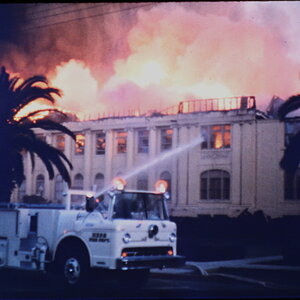Navigation
Install the app
How to install the app on iOS
Follow along with the video below to see how to install our site as a web app on your home screen.

Note: This feature currently requires accessing the site using the built-in Safari browser.
More options
You are using an out of date browser. It may not display this or other websites correctly.
You should upgrade or use an alternative browser.
You should upgrade or use an alternative browser.
Lenses going soft?
- Thread starter Bossy
- Start date
- Joined
- May 1, 2008
- Messages
- 25,418
- Reaction score
- 4,999
- Location
- UK - England
- Website
- www.deviantart.com
- Can others edit my Photos
- Photos OK to edit
There are, from what I can see, 4 typical causes to this:
1) Lens damage - a lens takes a drop or a knock which results in internal elements being shifted out of ideal alignment. As a result its overall performance degrades. Repair for this is possible of course, though won't be covered by warranties (but might be by insurance depending on your cover policy).
2) Lens wear and tear - any mechanical device is going to take a degree of wear and tear through normal, regular use. Lenses, especially pro series lenses; provided they are not abused whilst in use, are typically very resistant to degradation of performance. They'll typically retain their quality for many years (possibly even decades) without a problem. Recalibration is, of course possible.
3) User error - often accompanied with a new camera body. New camera bodies are often a little bit different to get the best out of, esp when the MP value increases. The result is users need to adapt editing and adjustment profiles to best suit the new situation. Some, however, missunderstand this step and start to blame the lens (or the body) for being broken/soft.
4) (and most common) Variations in production tolerances. Each mechanical device is made within manufacture tolerances which ensure that the average lens and average camera body do line up to give a typical grade performance. However there are situations where a specific body and specific lens might be at opposite ends of the tolerance ranges, the result of which is that when these two are combined the overall performance of the unit is degraded. People oft notice this with a new camera body and will blame either body or lens for this "poor performance" when in truth its both units simply not being lined up.
Correction for this is typically one of 3 ways
a) Return and replace - essentially returning the working lens/body and getting another unit - often repeating this several times until one appears with similar tolerances (this can be defeated since units from the same production line will often share similar tolerances and be shipped to the same retailers).
b) Recalibration of the single affected unit - under warranty for new units, however repair of one unit without the other "half" of the final setup is a bit of a lottery. The unit can come back better or worse even though its still "correct" by manufacture stats. This is, again, a bit of a lottery, though with provision of test shots one can normally get it fixed
c) Recalibration of both units (note one can state for camera bodies not to be adjusted during this since one might not send all the lenses they own in) - sending in both camera and lens allows for calibration to be made for those specific units. Many pros will send in complete setups (often there are pro groups setup by the manufacturers which offer discounts on services like this) so that they can be calibrated.
1) Lens damage - a lens takes a drop or a knock which results in internal elements being shifted out of ideal alignment. As a result its overall performance degrades. Repair for this is possible of course, though won't be covered by warranties (but might be by insurance depending on your cover policy).
2) Lens wear and tear - any mechanical device is going to take a degree of wear and tear through normal, regular use. Lenses, especially pro series lenses; provided they are not abused whilst in use, are typically very resistant to degradation of performance. They'll typically retain their quality for many years (possibly even decades) without a problem. Recalibration is, of course possible.
3) User error - often accompanied with a new camera body. New camera bodies are often a little bit different to get the best out of, esp when the MP value increases. The result is users need to adapt editing and adjustment profiles to best suit the new situation. Some, however, missunderstand this step and start to blame the lens (or the body) for being broken/soft.
4) (and most common) Variations in production tolerances. Each mechanical device is made within manufacture tolerances which ensure that the average lens and average camera body do line up to give a typical grade performance. However there are situations where a specific body and specific lens might be at opposite ends of the tolerance ranges, the result of which is that when these two are combined the overall performance of the unit is degraded. People oft notice this with a new camera body and will blame either body or lens for this "poor performance" when in truth its both units simply not being lined up.
Correction for this is typically one of 3 ways
a) Return and replace - essentially returning the working lens/body and getting another unit - often repeating this several times until one appears with similar tolerances (this can be defeated since units from the same production line will often share similar tolerances and be shipped to the same retailers).
b) Recalibration of the single affected unit - under warranty for new units, however repair of one unit without the other "half" of the final setup is a bit of a lottery. The unit can come back better or worse even though its still "correct" by manufacture stats. This is, again, a bit of a lottery, though with provision of test shots one can normally get it fixed
c) Recalibration of both units (note one can state for camera bodies not to be adjusted during this since one might not send all the lenses they own in) - sending in both camera and lens allows for calibration to be made for those specific units. Many pros will send in complete setups (often there are pro groups setup by the manufacturers which offer discounts on services like this) so that they can be calibrated.
nickzou
No longer a newbie, moving up!
- Joined
- Jun 12, 2011
- Messages
- 593
- Reaction score
- 40
- Location
- Ottawa
- Can others edit my Photos
- Photos NOT OK to edit
Ooh! I think I have problem 1) on an old Nikon 80-200 AF. If I take it into Nikon Canada, do you think the repair costs will be worth it? Or should I just buy a newer version? And how about a mode dial repair?
- Joined
- Apr 9, 2009
- Messages
- 41,401
- Reaction score
- 5,706
- Location
- Iowa
- Website
- kharrodphotography.blogspot.com
- Can others edit my Photos
- Photos OK to edit
Huh?
- Joined
- Apr 9, 2009
- Messages
- 41,401
- Reaction score
- 5,706
- Location
- Iowa
- Website
- kharrodphotography.blogspot.com
- Can others edit my Photos
- Photos OK to edit
How would we know how much the repair is going to cost, if we don't know what is wrong with the lens?Ooh! I think I have problem 1) on an old Nikon 80-200 AF. If I take it into Nikon Canada, do you think the repair costs will be worth it? Or should I just buy a newer version? And how about a mode dial repair?
Just like in the other thread, you're going to have to contact Nikon Canada Service, or some other qualified repair facility.
Most reactions
-
 426
426 -
 287
287 -
 280
280 -
 265
265 -
 222
222 -
 196
196 -
 182
182 -
 179
179 -
 164
164 -
 164
164 -
 150
150 -
 131
131 -
 118
118 -
 95
95 -
I
94
Similar threads
- Replies
- 0
- Views
- 175
- Replies
- 3
- Views
- 366






![[No title]](/data/xfmg/thumbnail/42/42267-2fff585000110a96fd9ac3ff09cceb95.jpg?1619740076)


![[No title]](/data/xfmg/thumbnail/37/37521-5e19cc15e190997d963ed09c3c13ca9c.jpg?1619738129)


![[No title]](/data/xfmg/thumbnail/33/33362-84aacb865117bf8cba89104b89e9b36c.jpg?1619735927)